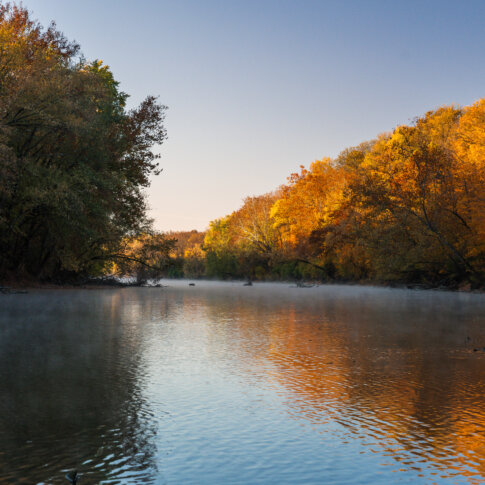The Virginia B. Fairbanks Art & Nature Park at Newfields encompasses nearly 100 acres of naturalized White River floodplain. Sitting on historically indigenous land that was used for row-crop agriculture and gravel mining before being left unmanaged for decades, Fairbanks Park has a diverse landscape which includes areas of mesic forest, wetland, prairie, and a 35-acre lake that is connected to the White River. The landscape’s diversity of habitat and proximity to the White River bring a lot of opportunities and challenges for conservation and the promotion of biodiversity. Current efforts to improve the ecological health of the park include mitigation of soil erosion, removal of invasive plants, and installation of native plants.
Erosion Mitigation
Soil stabilization and the reduction of sedimentation into the White River are constant challenges at Fairbanks Park. When the park was left unmanaged, the berm between the lake and the river, a remnant of the mining operation, became highly eroded, and the steep slopes of the riverbank populated with shallow-rooted, invasive plants. Invasive plants make stabilization a challenge as they disallow native plants with deeper roots to grow and often cause sections of soil to erode as root-balls disengage from the bank. Sections of the riverbank along the northern edge of the park now have a near-vertical or undercut slope due to years of erosion, and a section of the trail around the lake was once closed due to the hazards posed by steep slopes and unstable soils.

In 2014, Newfields hired Burke Engineering to conduct a study of soil erosion in Fairbanks Park and potential bank stabilization along the White River. This study determined that the existing berm prohibited the utilization of the river’s floodplain during bankfull flows. To solve this issue and prevent future scouring, a portion of the berm was reduced, allowing the river to overflow into the lake when necessary. Additionally, steep slopes of the riverbank were graded in some areas, and geotextile mat was used in conjunction with the planting of native vegetation to stabilize the bank and prevent future erosion. Erosion control efforts will continue over time in Fairbanks Park to assure continued, safe access to over a mile of riverfront.
Native Plants
Native plants are beneficial in obvious ways, such as the provision of food and shelter to native birds, pollinators, and other wildlife, but they are also critical for soil stabilization, water quality improvement, and invasive species mitigation. Native grasses and herbaceous plants stabilize soil due to stem density and the length of fine root fibers, and the root structures of native trees and shrubs are critical to prevent mass slope failure. Fairbanks Park utilizes a combination of these species to optimize soil stabilization on the property.

Having native plants in the floodplain also improves water quality in the White River and reduces flooding in the river corridor. The deep roots of native plants pull water down, where it is cleaned through microbial processes and taken in by plant roots. This reduces pollution and contributes to the natural storage of clean water in aquifers. Native species also provide competition for invasive ones, which helps with the maintenance of removal efforts.
A species composition study conducted by Butler University between 2004 and 2019, along with a subsequent floral inventory by Kevin Tungesvick, have shown that remediation efforts are working to improve the floristic quality of Fairbanks Park. More than 40 acres of Amur honeysuckle have been removed, and more than 20,000 native plants have been planted in the park since 2004.
Wild Birds Unlimited Pollinator Meadow
In 2019, the Virginia B. Fairbanks Art & Nature Park underwent its greatest effort yet to improve biodiversity and support the conservation of native species. A two-acre section of box elder and black locust dominant forest was strategically cleared, along with invasive plants in the understory, to create the Wild Birds Unlimited Pollinator Meadow, the largest planned pollinator meadow in Indianapolis.

Development and poor land management practices have contributed to widespread degradation and loss of meadows, a critical wildlife habitat for butterflies, birds, and other pollinators. As such, the survival of these species is heavily dependent on the development of new, dense, biodiverse stands. The Wild Bird Unlimited Pollinator Meadow was designed by Kevin Tungesvick, Senior Ecologist at EcoLogic, to optimize habitat and food resources for native birds and pollinators. The meadow includes more than 80 native species, with 48,984 individual plants installed over two years by Newfields’ volunteers, horticulturists, and natural resource specialists. As birds feast on seeds from this meadow, native plants will be spread throughout the adjacent landscape, extending the benefits beyond the park.
Newfields hopes that guests of the Virginia B. Fairbanks Art & Nature Park will be inspired by the beauty of the Wild Birds Unlimited Pollinator Meadow to plant more native plants in their own yards. Fairbanks Park welcomes you to join a Monarch butterfly tagging or seed collection event this fall, or to volunteer in the meadow as we watch this new treasure come alive!
All photos courtesy of Newfields.



